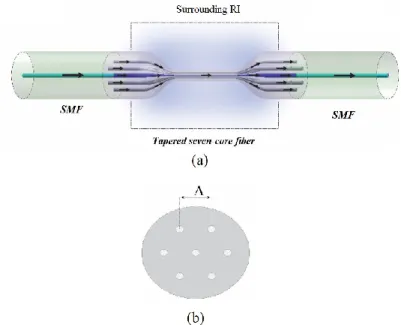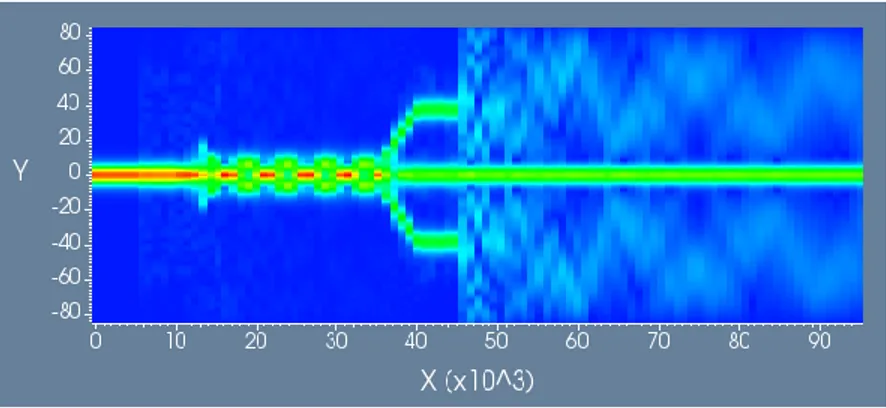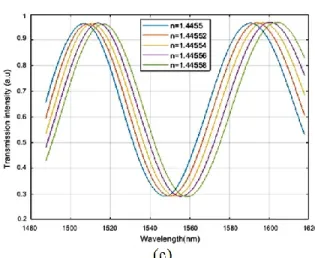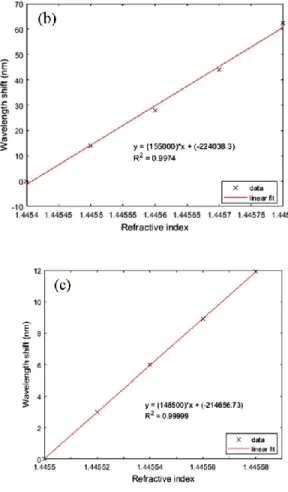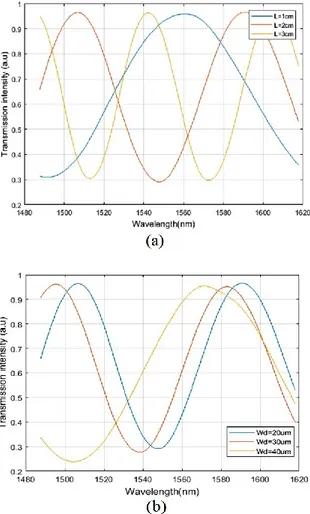DOI: 10.1501/commua1-2_0000000111 ISSN 1303-6009 E-ISSN 2618-6462
http://communications.science.ankara.edu.tr/index.php?series=A2A3
Received by the editors: July 24, 2018; Accepted: October 01, 2018.
Key word and phrases: Multicore fiber, refractive index sensing, tapered fiber, high sensitivity, beam propagation. © 2018 Ankara University Communications Faculty of Sciences University of Ankara Series A2-A3: Physical Sciences and Engineering
ULTRAHIGH SENSITIVE REFRACTIVE INDEX SENSOR BASED ON TAPERED MULTICORE OPTICAL FIBER
ZINAH ABBAS AL-MASHHADANI AND ISA NAVRUZ
Abstract. The refractive index sensors based on tapered optical fiber are attractive for many industries due to sensing capability in a variety of application. In this paper, we proposed a refractive index sensor based on multicore fiber (MCF) sandwiched between two standard single mode fibers (SMF). The sensor consisting of three sections, SMF- MCF-SMF is structurally simple and can be easily produced by joining these parts. The MFC contains seven cores and these cores are surrounded by a single cladding. The sensing region is obtained by tapering the MCF section where the evanescent field is generated. The single mode propagating along the SMF is stimulated at the first joint and is coupled to the cladding modes. These modes interfere with the core mode after passing the second joint. The transmission spectrum of the output light at the end of the third section is sensitive to the refractive index (RI) of the environment surrounding the cladding. In this study, the RI sensitivity of the proposed sensor was analyzed numerically and the RI sensing characteristic was investigated for different measurement ranges and different structural configurations. The results show that the refractive index sensitivity is extremely high in the range of about 1.44 to 1.45 RIU. In addition, the developed sensor has many advantages such as compact construction, low cost, small size and easy fabrication. It also has the potential to perform high precision measurements in fields such as biochemistry, health care and biological applications.
1. Introduction
Optical fiber refractive index (RI) sensors have been widely investigated for chemical, medical and biotechnological industries. All fiber RI sensors have been extensively used due to their unique advantages of high sensitivity, fast responding, compact size, low cost, immunity to electromagnetic interference, multiplexing and remote operation capability [1-4]. Many techniques for implementing RI sensing have been reported, such as using a fiber Bragg grating (FBG) [5], long period grating (LPG) [6], a Fabry-Perot interferometer [7], surface plasmon resonance [8],
ZINAH ABBAS AL-MASHHADANI AND ISA NAVRUZ 2
micro-sphere resonator [9], D-shaped fibers [10], tapered fiber [11 ], optical ring resonator [12], and the combination of two or more techniques above [13]. As an alternative to these existing techniques, hetero-core spliced fiber optic sensor based on core diameter mismatch has been proposed [14]. These sensors are easily fabricated by cutting and fusion splicing processes. The sensor structure consisting of two identical input and output single mode fibers SMFs axially spliced at both ends of a middle section of thin core fiber [15], coreless fiber [16], multi-mode fiber (MMF) [17], hollow core photonic crystal fiber (HCPCF) [18], two core fiber [19] or multicore fiber (MCF)[20].
In recent years, multi-core fiber have shown great interest in sensing application like temperature [21], curvature [22], strain [23], and shape sensing [24]. In this study, we present a high sensitive RI sensor based on MCF which is different from traditional single mode fiber. Jose et al. [19] have developed a novel fiber optic sensor based on a two core fiber for high performance measurements of RI of liquids. In their study, the maximum sensitivity of 3119 nm/RIU for RI range from 1.3160 to 1.3943 was experimentally measured. Ahmmed et al. [25] has implemented a multicore flat fiber based on surface plasmon resonance (SPR) sensor operating in telecommunication wavelengths for RI sensing. The modeled sensor showed a maximum sensitivity of 23,000 nm / RIU in the sensing range of 1.47-1.475. In a recent study, Chuanbiao et al. [20] have reported a scheme of splicing two single mode fibers to a section of tapered four-core fiber for RI sensing with a sensitivity of 171.2 nm / RIU in the range from 1.3448 to 1.3774 and with a tapered waist diameter of 81.3 µm. However, this sensitivity is not very high, but it can be improved by decreasing the waist diameter of the tapered section to meet more application scenarios.
In this work, a novel, highly sensitive seven cores MCF based on tapering technique is numerically demonstrated for the first time. Two identical SMFs are connected to both ends of a tapered MCF consisting of seven cores. Thus, a very simple sensor has been produced in terms of manufacturing and low cost. The change in the RI of the medium surrounding the sensing region directly shifts the transmission spectrum showing its sensitivity to external RI. Using MCF as a sensing region to the surrounding RI shows a great enhancement in sensitivity and extends the sensing RI range more than 1.4455 as compared with tapered standard SMF. Maximum sensitivity of 155000 nm/RIU in the RI range from 1.4454 to 1.4458 is numerically achieved. The RI response of the designed sensor is quite linear over a wide range. Our calculations show that the linear fitting coefficient, R2 (R-Squared) is higher than 0.99.
In addition, the effect of sensor design parameters such as the tapering length and tapering waist diameter on RI detection performance was also analyzed. The effect of sensor design parameters such as tapering length and tapering waist diameter on the RI sensing performance was also analyzed. The light propagation in the MCF section has been simulated employing a beam propagation method.
2. Sensing Principles
The schematic perspective of SMF-MCF-SMF structure is shown in Figure 1 (a). The MCF has one central core and six outer cores. The sensor was designed by inserting 2 cm section of MCF between two sections of SMF. The core of the input and output SMF are ideally aligned with center core of MCF. Both the SMF and MCF fibers have a step index profile and the core/cladding refractive indexes of SMF were 1.45 and 1.445 respectively and core/cladding diameters were 9/125 µm. Figure 1 (b) shows the cross sectional view of the untapered seven core MCF which was used in our sensor designs. The MCF has a diameter of 125 µm, and the diameter of all cores was 8.8 µm. The central core/outer six cores refractive index were 1.4535 and 1.4529 respectively. The refractive index of the MCF cladding was 1.45. The outer six cores have the same refractive index and were distributed in the six vertices of the regular hexagon. The distance between each core (pitch Λ) was 37.75 µm. The injected light injected from SMF into the MCF will excite multiple high order modes in the cladding of the MCF. These excited modes would propagate along the seven cores of MCF and interference between these multiple modes occurs and then back into the core of SMF [20]. On the other hand, the core/cladding diameter in the tapering region become thinner due to the tapering, so the light in core can be transmitted along with the surface of the tapered MCF due to the evanescent wave [26]. The propagation constant of the cladding mode is influenced by the RI of the surrounding environment. Thus, the relative phase difference between two interfering modes can be expressed by [20],
∆∅ =2𝜋
𝜆 (∆𝑛)𝐿 (2.1)
where λ is the wavelength of the light source, L is the length of the MCF, and ∆𝑛 is the effective refractive index difference, which can be expressed as,
ZINAH ABBAS AL-MASHHADANI AND ISA NAVRUZ 4
∆𝑛 = 𝑛𝑒𝑓𝑓𝑐𝑜 − 𝑛𝑒𝑓𝑓𝑜𝑢 (2.2) where 𝑛𝑒𝑓𝑓𝑐𝑜 is the effective refractive indices of core mode and 𝑛
𝑒𝑓𝑓
𝑜𝑢 is the effective
refractive indices of higher order modes out of the core. ∆𝑛 is a function of RI of both the MCF and the surrounding environment. Assuming the SMF and MCF are ideally aligned, when light travels from SMF to MCF, only 𝐿𝑃0𝑚 modes are excited in the MCF depending on the circular symmetry of the input field. If the input light in the SMF has a fundamental mode field distribution 𝐸(𝑟, 0) at z=0, then the input field can be decomposed into eigenmodes 𝐿𝑃0𝑚 in the MCF when the light enters the MCF section [17, 20]. By defining the field profile of 𝐿𝑃0𝑚 as a function of
𝛹𝑚(𝑟), the input field at the MCF can be written as [17],
𝐸(𝑟, 0) = ∑𝑀𝑚=1𝑏𝑚 𝛹𝑚(𝑟) (2.3)
where 𝛹𝑚(𝑟) are the eigenmodes of the MCF and 𝑏𝑚 is the excitation coefficient
of each mode. The field MCF section at a propagation distance L can be described as
𝐸(𝑟, 𝐿) = ∑ 𝑏𝑚 𝑚 𝐸1(𝑟)exp (𝑗𝛽𝑚𝐿) (2.4)
Figure 1. (a) the schematic diagram of the sensor, (b) a cross- sectional view of the seven core multicore fiber.
3. Bpm Numeric Simulation Results And Analysis
We carried out a simulation of light propagation through MCF and joint regions. We used BPM, which is suitable for long structure design. The initial condition for the BPM simulation was assumed to be a fundamental mode with wavelength of 1550 nm in first SMF. All simulations were carried out using two dimensional structures. The tapered waist diameter and tapered length were set to 20 µm and 2 cm, respectively. The upper and lower tapered region were each 5 mm long. An overall structure length of about 9 cm was used in all simulations. Figure 2 shows the distribution of electric field amplitude in the SMF-MCF-SMF structure for surrounding RI of 1.4455. It shows that most of the power stays in the central core, and after tapering region splits into upper and lower cores. When light enters the MCF, it excites the supermodes in the tapering region. After a specific distance, the interference of excited supermodes provides equal power distribution in each core.
ZINAH ABBAS AL-MASHHADANI AND ISA NAVRUZ 6
So, the power distribution at the output of the MCF is strongly depends on the taper waist length.
Figure 2. The electric field amplitude distribution of SMF-MCF-SMF fiber sensor with the tapered waist diameter of 20 µm and the tapered length of 2 cm. The surrounding RI is 1.4455 and the operating wavelength is 1550 nm. The X and Y axes represent the longitudinal and transverse directions of the optical fiber, respectively.
We simulated that how the surrounding RI change affect the multimode interference and hence the sensitivity of the sensor. Three different ranges of RI were used in the simulation. The selected RI value ranges are from 1.345 to 1.375, 1.4454 to 1.4458, and from 1. 4455 to 1.44558. It can be observed that the transmission spectrum moves toward longer wavelengths (red shifting) as the surrounding RI increases in each step. The wavelength dips shift about 7nm, 13nm and 2nm, when the RI change from 1.345 to 1.375, from 1.4454 to 1.4458, and from 1.4455 to 1.44558 as shown in Figure 3 (a), (b) and (c) respectively.
As shown in Figures 3 (b) and (c), small changes of 0.0001 and 0.00001 in the RI have resulted in wavelength shifts that can be easily measured in the transmission spectrum resulting in high sensitivity.
ZINAH ABBAS AL-MASHHADANI AND ISA NAVRUZ 8
Figure 3. Simulated spectral response of SMF-MCF-SMF for different surrounding RI. Tapered waist diameter and tapered length are 20 µm and 2 cm, respectively a) for the RI range of 1.345 to 1.375 (b) for the RI range of 1.4454 to 1.4458 (c) for the RI range of 1.4455 to 1.44558.
Figure 4 shows the simulated data of the wavelength-RI variation and the linear curve fitting for all three transmission spectrum. As expected, the sensitivity increases when the surrounding RI is around 1.445. The sensitivities for the RI range of 1.345-1.375, 1.4454-1.4458 and 1.4455-1.44558 are 703 nm/RIU, 155000 nm/RIU and 148500 nm/RIU, respectively. Their R2 coefficients are greater than 0.9974, which indicates that the wavelength shift exhibits good linear relationship with the RI change over a small RI range. The proposed sensor has a perfect RI sensing performance in the RI range 1.4454-1.4458 and 1.4455-1.44558.
Figure 4. Wavelength shift versus surrounding RI a) for the RI range of 1.345 to 1.375, b) for the RI range of 1.4454 to 1.4458, c) for the RI range of 1.4455 to 1.44558.
In order to analyze the sensing performance of the designed sensor, three sensors with different tapering parameters which are tapering length L and tapering waist diameter Wd were simulated. The sensitivity enhancement can be achieved by increasing the taper length or by creating thinner tapers, which increase ∆𝑛 as represented in Eq. 2. The beat length between the guided mode and the radiative modes increases with reduced fiber radius resulting in strongest coupling between the modes.
ZINAH ABBAS AL-MASHHADANI AND ISA NAVRUZ 10
Figure 5 (a) shows the transmission spectrum of the designed sensor with different tapering length of 1, 2 and 3cm. The tapering waist diameter Wd and surrounding RI were set to 20 µm and 1.4455, respectively. As the length of the tapering increases, the frequency of oscillations increases. However, an increase in the number of oscillations leads to reduction in the dynamic range of the sensor. On the other hand, Figure 5 (b) shows the transmission spectrum of the sensor with different tapering waist diameter 20, 30 and 40 µm.
Figure 5. Transmission spectrum of the sensor a) different tapering lengths from 1 to 3 cm b) different waist diameters from 20 to 40 μm.
It can be seen that the sensors with tapering waist diameter of 20 and 30 µm show almost same responses to RI changing as compared with waist diameter of 40 µm. In addition, although the sensor has a waist diameter as wide as 40 µm, oscillations in the spectrum indicate that the multiple modes in the sensing region still exhibits a strong interference influenced by the surrounding RI. This result cannot be achieved with tapered standard SMF only within this range of waist diameters as compared with our previous work [27].
4. Conclusion
In conclusion, we numerically demonstrated a RI sensor based on MCF fixed between two standard SMF sections. By employing tapering on the MCF as a sensing element, a sensitive RI detection could be obtained over a selected RI ranges. BPM is used to simulate the light propagation in the MCF and the sensing performance of the designed sensor to different sets of RI is analyzed. A maximum sensitivity of 155000 nm/RIU is obtained in the surrounding RI range from 1.4454 to 1.4458. The tapering length and the waist diameter are set to 2 cm and 20 µm, respectively, in all simulations. The RI sensitivity is increased with the increase of surrounding RI greater than 1.445. Using MCF with tapering technique shows a great sensitivity enhancement as compared with traditional tapered standard SMF. Moreover, the proposed sensor has many advantages, such as ease of production with conventional insertion, flexibility to work in different RI ranges, and small size. It can be used for high-resolution RI measurement in many areas such as chemistry, biology, biomedical or photonics applications.
References
[1] Zhao, Y., Cai, L., Li, X., Meng, F. and Zhao, Z., Investigation of the high sensitivity RI sensor based on SMS fiber structure, Sens. and Act. A, 205 (2014) 186-190.
[2] Cohoon, G., Boyter, C. H., Errico, M., Vandervoort, K. and Salik, E., Enhancing sensitivity of biconical tapered fiber sensors with multiple passes through the taper, Opt. Eng., 49 (3) (2010) 034401.
ZINAH ABBAS AL-MASHHADANI AND ISA NAVRUZ 12
[3] Goh, L., Anoda, Y., Kazuhiro, W. and Shinomiya, N., Remote Management for Multipoint sensing system using hetero-core spliced optical fiber sensors, Sens., 14 (2014) 468-477.
[4] Wang, P., Brambilla, G., Ding, M., Semenova, Y., Wu, Q. and Farrell, G., High-sensitivity, evanescent field refractometric sensor based on a tapered, multimode fiber interference, Opt. Lett., 36 (12) (2011) 2233-2235.
[5] Han, M, Guo, F.W. and Lu, Y. F., Optical fiber refractometer based on cladding-mode Bragg grating, Opt. Lett., 35 (2010) 399-401.
[6] Korposh, S., Lee, S.W., James, S.W. and Tatam, R.P., Refractive index sensitivity of fiber-optic long period gratings coated with SiO2 nanoparticle mesoporous thin films, Meas. Sci. Technol., 22 (2011) 075208.
[7] Jiejun, Z., Qizhen, S., Ruibing, L., Jianghai, W., Deming L. and Perry, Sh., Microfiber Fabry–Perot interferometer fabricated by taper-drawing technique and its application as a radio frequency interrogated refractive index sensor,
Opt. Lett. , 37 (14) (2012) 2925-2927.
[8] Wu, X., Zhang, J., Chen, J., Zhao, Ch., and Gong, Q., Refractive index sensor based on surface-plasmon interference, Opt. Lett., 34 (3) (2009) 392-394. [9] Dong, Y., Wang, K. and Jin, X., Package of a dual-tapered-fiber coupled
microsphere resonator with high Q factor, Opt. Comm., 350 (1) (2015) 230-234. [10] Del Villar, I., Zubiate, P., Zamarreño, C.R., Arregui, F. J. and Matias, I.R., Optimization in nanocoated D-shaped, Opt. Fib. Sens.”, 25 (10), (2017) 10743-10756.
[11] Tai, Y.H. and Wei, P.K., Sensitive liquid refractive index sensors using tapered optical fiber tips, Opt. Lett., 35 (2010) 944-946.
[12] Sarkaleh, A.K., Lahijani, B.V., Saberkari, H. and Esmaeeli, A., Optical Ring Resonators: A Platform for Biological Sensing Applications, J. Med. Signal
Sens., 7 (3) (2017) 185-191.
[13] Shao, L., Zhao, J., Dong, X., Tam, H. Y., Lu, C. and He, S., Long-period prating fabricated by periodically tapering standard single-mode fiber, Appl. Opt., 47 (10) (2008) 1549-1552.
[14] Lee, G., Kumekawa, N., Watanabe, K. and Shinomiya, N., Hetero-core spliced optical fiber SPR sensor system for soil gravity water monitoring in agricultural environments, Comp. and Elec. in Agriculture, 101 (2014) 110-117.
[15] Shi, J., Xiao, S., Yi, L. and Bi, M., A Sensitivity-Enhanced Refractive Index Sensor Using a Single-Mode Thin-Core Fiber Incorporating an Abrupt Taper,
Sensors, 12 (2012) 4697-4705.
[16] Yang, L., Zhibo, L. and Shuisheng, J., Multimode interference refractive index sensor based on coreless fiber, Photonic Sens., 4 (1) (2014) 21-27.
[17] Qiang, W., Yuliya, S., Pengfei, W. and Gerald, F., High sensitivity SMS fiber structure based refractometer-analysis and experiment, Opt. exp., 19 (9) (2011) 7937-7944.
[18] Baharin, N.F, Sidek, N., Musa, M.A., Azmi, A.I., Abdullah, A.S., Noor, M.Y.M. and Roslan, E. M., Hollow-core photonic crystal fiber refractive index sensor based on modal interference, J. of Eng. and App. Scien., 11 (9) (2016) 5702-06.
[19] Guzmán-Sepúlveda, J.R., Guzmán-Cabrera, R., Torres-Cisneros, M., Sánchez-Mondragón, J.J. and May-Arrioja, A highly sensitive fiber optic sensor based on two-core fiber for refractive index measurement, Sens., 13 (10) (2013) 14200-13.
[20] Zhang, Ch., Ning, T., Li, J., Pei, L., Li, Ch. and Lin, H., Refractive index sensor based on tapered multicore fiber, Opt. Fib. Tech., 33, 71-76, 2017.
[21] Yang, J., Jiang, L., Wang, S., High sensitivity of taper-based Mach-Zehnder interferometer embedded in a thinned optical fiber for refractive index sensing,
Appl. Opt., 50 (28) (2011) 5503-5507.
[22] Kim, B., Kim, T., Cui, L., Twin core photonic crystal fiber for in-line Mach-Zehnder interferometric sensing application, Opt. Exp., 17 (18) (2009) 15502-07.
[23] Hu, J., Huang, H., Bai, M., Zhan, T., Yang, Z., Yu, Y. and Qu, B., A high sensitive fiber-optic strain sensor with tunable temperature sensitivity for temperature-compensation measurement, Scien. Rep., 7 (2017) 42430.
[24] Kissinger, T., Chehura, E., Staines, S.E., James, S.W. and Tatam, R.P., Dynamic fiber-optic shape sensing using fiber segment interferometry, J. of
Lightw. Techn., 36 (4) (2018) 917-925.
[25] Rifat, A.A., Mahdiraji, G.A., Sua, Y.M., Ahmed, R., Shee, Y.G. and Mahamd Adikan, F.R., Highly sensitive multi-core flat fiber surface plasmon resonance refractive index sensor, Opt. Exp., 24 (3), (2016) 2485-2495.
[26] Xing-hu, F., Yan-li, X, Qin, L, Hai-yanh, X, Chuan-qing, Y, Shun-yang, Z, Guang-wei, F. and Wei-hong, B., Refractive index sensors based on the fused taper special multi-mode fiber, Optoelect. Lett., 12 (1) (2016) 12-15.
[27] Navruz, I., Ari, F. and Bilsel, M., Shape optimization of bioconical optical fiber sensor for maximum detection, I. International Scientific and Vocational
ZINAH ABBAS AL-MASHHADANI AND ISA NAVRUZ 14
Current Address: ZINAH ABBAS AL-MASHHADANI: Ankara University,
Faculty of Engineering, Department of Electrical and Electronics Engineering, Ankara TURKEY
E-mail : baghdad_zaa@yahoo.com
ORCID: https://orcid.org/0000-0002-2199-7335
Current Address: ISA NAVRUZ: Ankara University, Faculty of Engineering,
Department of Electrical and Electronics Engineering, Ankara TURKEY
E-mail : inavruz@ankara.edu.tr
